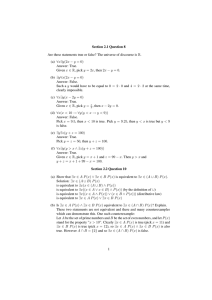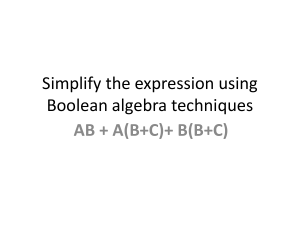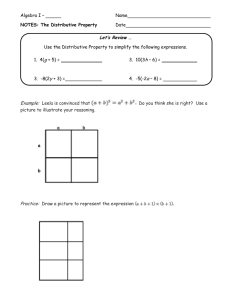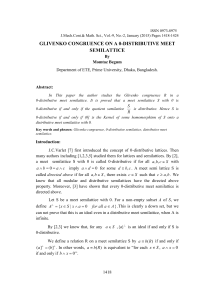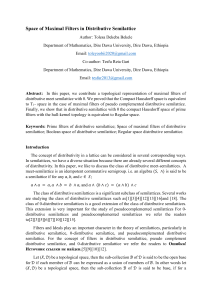Semilattice Congruencies: Theorem Proofs & Distributive Properties
advertisement
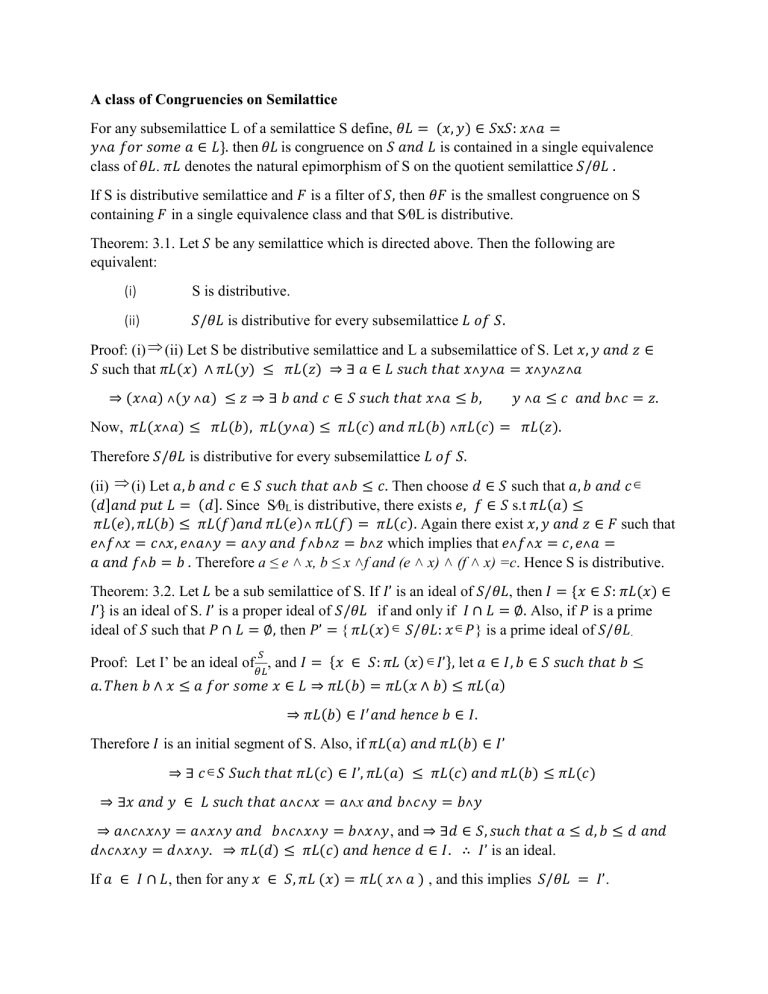
A class of Congruencies on Semilattice
For any subsemilattice L of a semilattice S define, 𝜃𝐿 = (𝑥, 𝑦) ∈ 𝑆x𝑆: 𝑥˄𝑎 =
𝑦˄𝑎 𝑓𝑜𝑟 𝑠𝑜𝑚𝑒 𝑎 ∈ 𝐿}. then 𝜃𝐿 is congruence on 𝑆 𝑎𝑛𝑑 𝐿 is contained in a single equivalence
class of 𝜃𝐿. 𝜋𝐿 denotes the natural epimorphism of S on the quotient semilattice 𝑆/𝜃𝐿 .
If S is distributive semilattice and 𝐹 is a filter of 𝑆, then 𝜃𝐹 is the smallest congruence on S
containing 𝐹 in a single equivalence class and that S⁄θL is distributive.
Theorem: 3.1. Let 𝑆 be any semilattice which is directed above. Then the following are
equivalent:
(i)
S is distributive.
(ii)
𝑆/𝜃𝐿 is distributive for every subsemilattice 𝐿 𝑜𝑓 𝑆.
Proof: (i) (ii) Let S be distributive semilattice and L a subsemilattice of S. Let 𝑥, 𝑦 𝑎𝑛𝑑 𝑧 ∈
𝑆 such that 𝜋𝐿(𝑥) ∧ 𝜋𝐿(𝑦) ≤ 𝜋𝐿(𝑧) ⇒ ∃ 𝑎 ∈ 𝐿 𝑠𝑢𝑐ℎ 𝑡ℎ𝑎𝑡 𝑥˄𝑦˄𝑎 = 𝑥˄𝑦˄𝑧˄𝑎
⇒ (𝑥˄𝑎) ˄(𝑦 ˄𝑎) ≤ 𝑧 ⇒ ∃ 𝑏 𝑎𝑛𝑑 𝑐 ∈ 𝑆 𝑠𝑢𝑐ℎ 𝑡ℎ𝑎𝑡 𝑥˄𝑎 ≤ 𝑏,
𝑦 ˄𝑎 ≤ 𝑐 𝑎𝑛𝑑 𝑏˄𝑐 = 𝑧.
Now, 𝜋𝐿(𝑥˄𝑎) ≤ 𝜋𝐿(𝑏), 𝜋𝐿(𝑦˄𝑎) ≤ 𝜋𝐿(𝑐) 𝑎𝑛𝑑 𝜋𝐿(𝑏) ˄𝜋𝐿(𝑐) = 𝜋𝐿(𝑧).
Therefore 𝑆/𝜃𝐿 is distributive for every subsemilattice 𝐿 𝑜𝑓 𝑆.
(ii) (i) Let 𝑎, 𝑏 𝑎𝑛𝑑 𝑐 ∈ 𝑆 𝑠𝑢𝑐ℎ 𝑡ℎ𝑎𝑡 𝑎˄𝑏 ≤ 𝑐. Then choose 𝑑 ∈ 𝑆 such that 𝑎, 𝑏 𝑎𝑛𝑑 𝑐
(𝑑]𝑎𝑛𝑑 𝑝𝑢𝑡 𝐿 = (𝑑]. Since S⁄θL is distributive, there exists 𝑒, 𝑓 ∈ 𝑆 s.t 𝜋𝐿(𝑎) ≤
𝜋𝐿(𝑒), 𝜋𝐿(𝑏) ≤ 𝜋𝐿(𝑓)𝑎𝑛𝑑 𝜋𝐿(𝑒)˄ 𝜋𝐿(𝑓) = 𝜋𝐿(𝑐). Again there exist 𝑥, 𝑦 𝑎𝑛𝑑 𝑧 ∈ 𝐹 such that
𝑒˄𝑓˄𝑥 = 𝑐˄𝑥, 𝑒˄𝑎˄𝑦 = 𝑎˄𝑦 𝑎𝑛𝑑 𝑓˄𝑏˄𝑧 = 𝑏˄𝑧 which implies that 𝑒˄𝑓˄𝑥 = 𝑐, 𝑒˄𝑎 =
𝑎 𝑎𝑛𝑑 𝑓˄𝑏 = 𝑏 . Therefore a ≤ e ˄ x, b ≤ x ˄f and (e ˄ x) ˄ (f ˄ x) =c. Hence S is distributive.
Theorem: 3.2. Let 𝐿 be a sub semilattice of S. If 𝐼’ is an ideal of 𝑆/𝜃𝐿, then 𝐼 = {𝑥 ∈ 𝑆: 𝜋𝐿(𝑥) ∈
𝐼’} is an ideal of S. 𝐼’ is a proper ideal of 𝑆/𝜃𝐿 if and only if 𝐼 ∩ 𝐿 = ∅. Also, if 𝑃 is a prime
ideal of 𝑆 such that 𝑃 ∩ 𝐿 = ∅, then 𝑃’ = { 𝜋𝐿(𝑥) 𝑆/𝜃𝐿: 𝑥 𝑃} is a prime ideal of 𝑆/𝜃𝐿.
𝑆
Proof: Let I’ be an ideal of𝜃𝐿, and 𝐼 = {𝑥 ∈ 𝑆: 𝜋𝐿 (𝑥) 𝐼’}, let 𝑎 ∈ 𝐼, 𝑏 ∈ 𝑆 𝑠𝑢𝑐ℎ 𝑡ℎ𝑎𝑡 𝑏 ≤
𝑎. 𝑇ℎ𝑒𝑛 𝑏 ∧ 𝑥 ≤ 𝑎 𝑓𝑜𝑟 𝑠𝑜𝑚𝑒 𝑥 ∈ 𝐿 ⇒ 𝜋𝐿(𝑏) = 𝜋𝐿(𝑥 ∧ 𝑏) ≤ 𝜋𝐿(𝑎)
⇒ 𝜋𝐿(𝑏) ∈ 𝐼 ′ 𝑎𝑛𝑑 ℎ𝑒𝑛𝑐𝑒 𝑏 ∈ 𝐼.
Therefore 𝐼 is an initial segment of S. Also, if 𝜋𝐿(𝑎) 𝑎𝑛𝑑 𝜋𝐿(𝑏) ∈ 𝐼’
⇒ ∃ 𝑐 𝑆 𝑆𝑢𝑐ℎ 𝑡ℎ𝑎𝑡 𝜋𝐿(𝑐) ∈ 𝐼’, 𝜋𝐿(𝑎) ≤ 𝜋𝐿(𝑐) 𝑎𝑛𝑑 𝜋𝐿(𝑏) ≤ 𝜋𝐿(𝑐)
⇒ ∃𝑥 𝑎𝑛𝑑 𝑦 ∈ 𝐿 𝑠𝑢𝑐ℎ 𝑡ℎ𝑎𝑡 𝑎˄𝑐˄𝑥 = 𝑎˄x 𝑎𝑛𝑑 𝑏˄𝑐˄𝑦 = 𝑏˄𝑦
⇒ 𝑎˄𝑐˄𝑥˄𝑦 = 𝑎˄𝑥˄𝑦 𝑎𝑛𝑑 𝑏˄𝑐˄𝑥˄𝑦 = 𝑏˄𝑥˄𝑦, and ⇒ ∃𝑑 ∈ 𝑆, 𝑠𝑢𝑐ℎ 𝑡ℎ𝑎𝑡 𝑎 ≤ 𝑑, 𝑏 ≤ 𝑑 𝑎𝑛𝑑
𝑑˄𝑐˄𝑥˄𝑦 = 𝑑˄𝑥˄𝑦. ⇒ 𝜋𝐿(𝑑) ≤ 𝜋𝐿(𝑐) 𝑎𝑛𝑑 ℎ𝑒𝑛𝑐𝑒 𝑑 ∈ 𝐼. ∴ 𝐼’ is an ideal.
If 𝑎 ∈ 𝐼 ∩ 𝐿, then for any 𝑥 ∈ 𝑆, 𝜋𝐿 (𝑥) = 𝜋𝐿( 𝑥˄ 𝑎 ) , and this implies 𝑆/𝜃𝐿 = 𝐼’.
Conversely if𝑆/𝜃𝐿 = 𝐼’, then for any 𝑥 ∈ 𝐿, 𝜋𝐿(𝑥) 𝐼’ and therefore 𝐼 ∩ 𝐿 ≠ ∅.
Also let P be prime ideal of S such that 𝑃 ∩ 𝐿 = ∅, then 𝑃’ is proper ideal of 𝑆/𝜃𝐿 and
Let 𝜋𝐿(𝑎) ∧ 𝜋𝐿(𝑏) ∈ 𝑃′ , 𝜋𝐿(𝑎 ∧ 𝑏) ∈ 𝑃′ . Then 𝑎 ∧ 𝑏 ∈ 𝑃 𝑎𝑛𝑑 𝑠𝑖𝑛𝑐𝑒 𝑃 𝑖𝑠 𝑝𝑟𝑖𝑚𝑒 𝑎 ∈ 𝑃 𝑜𝑟 𝑏 ∈
𝑃. Hence 𝜋𝐿(𝑎) ∈ 𝑃′ 𝑜𝑟 𝜋𝐿(𝑏) ∈ 𝑃′ . Therefore 𝑃’ is prime
Theorem: 3.3. Let 𝐿1 𝑎𝑛𝑑 𝐿2 be two sub semilattices of S such that 𝐿1 𝐿2 and also let
𝑓: S⁄θL1 S⁄θL2 be the epimorphism defined by 𝑓 𝜋𝐿1(𝑥) = 𝜋𝐿2(𝑥), If 𝑓 is injection, then
𝑃 ∩ 𝐿1 = ∅ implies 𝑃 ∩ 𝐿2 = ∅, for any prime ideal P of S,
Proof: If P is a prime ideal of S such that 𝑃 ∩ 𝐿1 = ∅, then by theorem 3.2 above, {πL1(x) ∈
S⁄θL1} is a prime ideal of S⁄θL1 and hence { πL2(x) ∈S⁄θL2: x∈P} is a prime ideal of S⁄θL2, so that
𝑃 ∩ 𝐿2 = ∅.
Theorem: 3.4. Let 𝐹 be a filter of S, then the following are equivalent:
(i)
𝐹 𝑖𝑠 𝑎 𝑝𝑟𝑖𝑚𝑒 𝑓𝑖𝑙𝑡𝑒𝑟.
(ii)
𝐼 = {𝜋𝐹(𝑥): 𝑥 ∈ 𝑆 − 𝐹} 𝑖𝑠 𝑎𝑛 𝑖𝑑𝑒𝑎𝑙 𝑜𝑓 𝑆/𝜃𝐹 .
(iii)
𝑆/𝜃𝐹 ℎ𝑎𝑠 𝑎 𝑢𝑛𝑖𝑞𝑢𝑒 𝑚𝑎𝑥𝑖𝑚𝑎𝑙 𝑖𝑑𝑒𝑎𝑙.
Proof: (i)⇒(ii) Suppose that 𝐹 is a prime filter, then 𝑆 − 𝐹 is prime ideal of S. 𝐿𝑒𝑡 𝜋𝐹(𝑥) ∈
𝐼 𝑎𝑛𝑑 𝜋𝐹(𝑦) ∈ 𝑆/𝜃𝐹 𝑠𝑢𝑐ℎ 𝑡ℎ𝑎𝑡 𝜋𝐹(𝑦) ≤ 𝜋𝐹(𝑥) ⇒ ∃ 𝑎 ∈ 𝐹 𝑠𝑢𝑐ℎ 𝑡ℎ𝑎𝑡 𝑦 ∧ 𝑎 = 𝑥 ∧ 𝑦 ∧
𝑎 ⇒ 𝑦 ∧ 𝑎 ≤ 𝑥 ⇒ 𝜋𝐹(𝑦) = 𝜋𝐹(𝑦 ∧ 𝑎) ≤ 𝜋𝐹(𝑥) ⇒ 𝜋𝐹(𝑦) ≤ 𝜋𝐹(𝑥)
∴ I is initial segment.
Let 𝜋𝐹(𝑥), 𝜋𝐹(𝑦) ∈ 𝐼, this implies 𝑥, 𝑦 ∈ 𝑆 − 𝐹 which is prime ideal of S.
⇒ ∃ 𝑧 ∈ 𝑆 − 𝐹 𝑠𝑢𝑐ℎ 𝑡ℎ𝑎𝑡 𝑥 ≤ 𝑧 𝑎𝑛𝑑 𝑦 ≤ 𝑧.
⇒ ∃ 𝑎 ∈ 𝐹 𝑠𝑢𝑐ℎ 𝑡ℎ𝑎𝑡 𝑥 ∧ 𝑎 = 𝑥 ∧ 𝑎 ∧ 𝑧 𝑎𝑛𝑑 𝑦 ∧ 𝑎 = 𝑦 ∧ 𝑎 ∧ 𝑧,
⇒ 𝑥 ∧ 𝑎 ≤ 𝑧 𝑎𝑛𝑑 𝑦 ∧ 𝑎 ≤ 𝑧
⇒ 𝜋𝐹(𝑥) = 𝜋𝐹(𝑥 ∧ 𝑎) ≤ 𝜋𝐹(𝑧) 𝑎𝑛𝑑 𝜋𝐹(𝑦) = 𝜋𝐹(𝑦 ∧ 𝑎) ≤ 𝜋𝐹(𝑧)
⇒ 𝜋𝐹(𝑥) ≤ 𝜋𝐹(𝑧) 𝑎𝑛𝑑 𝜋𝐹(𝑦) ≤ 𝜋𝐹(𝑧)
Therefore 𝐼 = {𝜋𝐹(𝑥): 𝑥 ∈ 𝑆 − 𝐹} is an ideal of 𝑆/𝜃𝐹 .
(ii)⇒ (iii) 𝐹𝑜𝑟 𝑎𝑛𝑦 𝑎 ∈ 𝐹, 𝜋𝐹(𝑎) is the greatest element of 𝑆/𝜃𝐹. Hence, every ideal of 𝑆/𝜃𝐹 is
contained in {𝜋𝐹(𝑥): 𝑥 ∈ 𝑆 − 𝑃}.Therefore 𝑆/𝜃𝐹 has a unique maximal.
(iii)⇒ (i): Let G be the unique maximal ideal of 𝑆/𝜃𝐹 and let 𝑥 𝑎𝑛𝑑 𝑦 𝜖 𝑆 − 𝐹. Since the
principal ideals of 𝑆/𝜃𝐹 generated by 𝜋𝐹(𝑥) 𝑎𝑛𝑑 𝜋𝐹(𝑦) are proper, it follows that
𝜋𝐹(𝑥)𝑎𝑛𝑑 𝜋𝐹(𝑦) ∈ 𝐺. Therefore there exists 𝜋𝐹(𝑧) ∈ 𝐺 𝑠𝑢𝑐ℎ 𝑡ℎ𝑎𝑡 𝜋𝐹(𝑥) ≤ 𝜋𝐹(𝑧) and
𝜋𝐹(𝑦) ≤ 𝜋𝐹(𝑧), 𝑠𝑜 𝑡ℎ𝑎𝑡 𝑥˄𝑧˄𝑎 = 𝑥˄𝑎 𝑎𝑛𝑑 𝑦˄𝑧˄𝑎 = 𝑦˄𝑎 𝑓𝑜𝑟 𝑠𝑜𝑚𝑒 𝑎𝜖𝐹.
𝑇ℎ𝑒𝑟𝑒𝑓𝑜𝑟𝑒 𝑡ℎ𝑒𝑟𝑒 𝑒𝑥𝑖𝑠𝑡𝑠 𝑏𝜖𝑆 𝑠𝑢𝑐ℎ 𝑡ℎ𝑎𝑡 𝑥 ≤ 𝑏, 𝑦 ≤ 𝑏 𝑎𝑛𝑑 𝑏˄𝑧˄𝑎 = 𝑏˄𝑎,
This implies 𝑏 ∈ 𝑆 − 𝐹, thus 𝑆 − 𝐹 is a prime ideal. Hence 𝐹 is prime filter.
Theorem: 3.5. Let F be a filter of S. Then 𝐹 is a maximal filter if and only if 𝑆/𝜃𝐹 is the two
element chain.
Proof: Suppose F is a maximal filter, then for any 𝑥 𝑎𝑛𝑑 𝑦𝜖 𝐹, 𝜋𝐹(𝑥) = 𝜋𝐹(𝑦) and that for
any 𝑥 ∈ 𝐹 𝑎𝑛𝑑 𝑦 ∈ 𝑆, 𝜋𝐹(𝑥) = 𝜋𝐹(𝑦) implies 𝑦 ∈ 𝐹.
Now, 𝑙𝑒𝑡 𝑥 𝑎𝑛𝑑 𝑦 ∈ 𝑆 − 𝐹, Since 𝐹 is maximal, there exist 𝑎 𝑎𝑛𝑑 𝑏𝜖 𝐹 𝑠𝑢𝑐ℎ 𝑡ℎ𝑎𝑡
𝑎˄𝑥 ≤ 𝑦 𝑎𝑛𝑑 𝑏˄𝑦 ≤ 𝑥 . 𝐻𝑒𝑛𝑐𝑒 𝜋𝐹(𝑥) = 𝜋𝐹(𝑎˄𝑥) ≤ 𝜋𝐹(𝑦) = 𝜋𝐹(𝑏˄𝑦) ≤ 𝜋𝐹(𝑥).
𝑆𝑜 𝑡ℎ𝑎𝑡 𝜋𝐹(𝑥) = 𝜋𝐹(𝑦).
Conversely, suppose that 𝑆/𝜃𝐹 is the two element chain. Suppose 𝑥 𝑎𝑛𝑑 𝑦 ∈ 𝑆 − 𝐹. Choose an
element 𝑧 ∈ 𝐹, then we have 𝜋𝐹(𝑧) ≠ 𝜋𝐹(𝑥) and Hence 𝜋𝐹(𝑥) = 𝜋𝐹(𝑦) so that there exists
𝑎 ∈ 𝐹 𝑠𝑢𝑐ℎ 𝑡ℎ𝑎𝑡 𝑥˄𝑎 = 𝑦˄𝑎 𝑎𝑛𝑑 𝑇ℎ𝑒𝑟𝑒𝑓𝑜𝑟𝑒 𝑦 ∈ 𝐹 ∨ [𝑥). Hence, for any 𝑥 ∉ 𝐹, 𝐹 ∨ [𝑥) = 𝑆.
Thus 𝐹 is maximal.
Theorem: 3.6. The map F⟼θF is an isomorphism from the lattice F0(S) of all non empty filters
of S into a permutable sublattice of the lattice C(S) of all congruencies on S.
Hence {θF: F ϵ F0(S)} is a distributive and permutable sublattice of C(S).
Proof: For any filters I and J of S. then θI∩J⊂ θI∩θJ and let (x, y) ∈ θI∩θJ, there exist 𝑎 ∈
𝐼, 𝑏 𝜖𝐽 𝑠𝑢𝑐ℎ 𝑡ℎ𝑎𝑡 𝑥 ∧ 𝑎 = 𝑦 ∧ 𝑎 𝑎𝑛𝑑 𝑥 ∧ 𝑏 = 𝑦 ∧ 𝑏 ⇒ ∃𝑐 ∈ 𝑆 𝑠𝑢𝑐ℎ 𝑡ℎ𝑎𝑡 𝑎 ≤ 𝑐, 𝑏 ≤ 𝑐 𝑎𝑛𝑑 𝑥 ∧
𝑐 = 𝑦 ∧ 𝑐. Now since 𝑐 ∈ 𝐼 ∩ 𝐽, 𝑤𝑒 ℎ𝑎𝑣𝑒 (𝑥, 𝑦) ∈ 𝜃𝐼 ∩ 𝐽. Hence F⟼θF is a lattice
homomorphism. 𝐴𝑙𝑠𝑜 𝑙𝑒𝑡 𝐼 𝑎𝑛𝑑 𝐽 ∈ 𝐹0(𝑆) 𝑎𝑛𝑑 𝜃𝐼 ⊂ 𝜃𝐽. Let 𝑥 ∈ 𝐼, choose 𝑦 ∈ 𝐽 and then there
exist 𝑧 ∈ 𝑆 such that 𝑥 ≤ 𝑧 and 𝑦 ≤ 𝑧. 𝑁𝑜𝑤 (𝑥, 𝑦) ∈ 𝜃𝐼 ⊂ 𝜃𝐽 and since 𝑧 𝜖𝐽, we have 𝑥 𝜖𝐽 and
therefore 𝐼 ⊂ 𝐽 and hence F⟼θF is a lattice isomorphism of F0(S) onto the sublattice {θF: F
∈F0(S)} of C(S).
Remark: The lattice C(S) of all congruencies on a semilattice S need not be distributive, even
when S is distributive. For example let 𝑆 = 𝕫+ ∪ {0, 𝑎, 𝑏}, with partial order given by 0 < 𝑎 < 𝑛,
0 < 𝑏 < 𝑛, for all 𝑛 ∈ 𝕫+ and 𝑚 < 𝑛 𝑤ℎ𝑒𝑛 𝑒𝑣𝑒𝑟 𝑚 − 𝑛 is positive for all 𝑚, 𝑛 ∈ 𝕫+. Then S
becomes distributive semilattice, with a∧b=glb{a, b} , ∀ a, b∈ S.
Let θ ={(a, b), (0,a), (0,b), (b,a), (a,0), (b,0) }∪ {(x,x):x∈S},
α = {(x, y)∈SxS:x∧a=y∧a}, β= {(x, y)∈SxS :x∧b=y∧b}.
Define θ∧α=θ∩α={(x,y)∈SxS:(x,y)∈θ and (x,y)∈α} and θ∨α=θοα={(x,y)∈SxS: ∃z∈S such
that=(x,z)∈α and (z,y)∈θ}.Then (θ∨α)∧β≠(θ∧β)∨(α∧β), Since (1, b)∈β∧(θ∨α) and (1,
b)∉(θ∧β)∨(α∧β).
